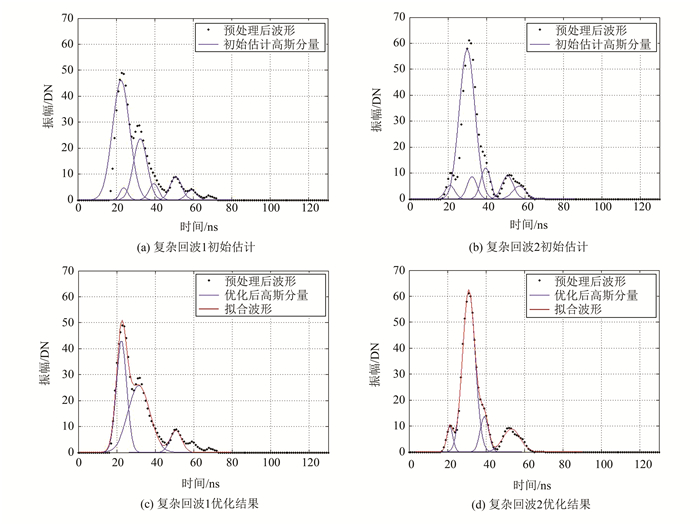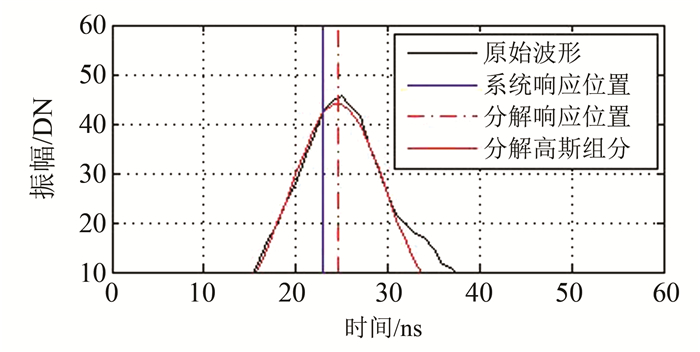-
摘要: 针对机载激光雷达波形数据分解易受噪声影响,高斯组分个数及叠加波初始参数估计不精确等问题,提出了一种横向高斯波形分解方法。该方法首先对波形进行滤波平滑处理,剔除背景噪声后,将检测到的波峰划分为不同的类型,分别估计其初始参数;然后横向逐步迭代分解估计初始高斯分量,在去除无效的初始高斯分量后,利用列文伯格-马夸尔特(Levenberg-Marquardt)算法进一步优化参数;最后解算得到分解点云。实验结果表明,该方法能有效地检测各种类型的回波信号,对叠加波形具有良好的适应性,并能在一定程度上保护弱波。相比系统点云,本文方法解算的点云在数量和细节上更具有优势,反映了更加丰富的地物垂直结构信息以及在森林参数获取方面的应用潜力。
-
关键词:
- 全波形数据 /
- 高斯分解 /
- 列文伯格-马夸尔特算法 /
- 分解点云
Abstract: The decomposition of waveform data is a key step in waveform analysis. Traditional wave-form decomposition methods cannot detect overlapped sub-waveforms and weak sub-waveforms, and cannot appropriately estimate the number of Gaussian components. In this article, we propose a lateral Gaussian decomposition method. A waveform is smoothed after removing the background noise. We divide the detected waves into different types of waveforms, and estimate their initial parameters with different methods, then progressively laterally decompose waveform until all the Gaussian components are decided. After removing invalid components, we usethe Levenberg-Marquardt method to further optimize the parameters. Experiments show that this new method can effectively detect different kinds of complicated waveforms; demonstrating both robustness and efficiency.-
Keywords:
- full-waveform /
- Gaussian decomposition /
- LM method /
- generate point cloud
-
公路、铁路隧道施工多采用矿山法、明挖法或暗挖法。在施工过程中需要对其超欠挖情况进行快速、准确地检测与评估,对控制施工成本、分析围岩稳定性、确保施工安全具有重要意义。传统检测方法使用全站仪、断面仪等设备对断面进行逐点测量,无法对全断面进行检测,效率较低。三维激光扫描技术具备高穿透性、高密度、高精度等特点,将其应用于隧道超欠挖检测,能够快速获取施工区域隧道绝对点云,实现目标断面提取、超欠挖检测、超欠挖方量计算等目标。
使用激光点云进行隧道超欠挖检测的一般思路是获取隧道中线[1-6]、点云滤波[7]、截面提取及超欠挖计算。文献[8-9]将地面三维激光扫描技术应用于隧道全断面变形测量,给出测站间距和扫描分辨率的最佳取值;文献[10]基于非均匀有理B样条(non-uniform rational B-splines, NURBS)曲面理论,对配准、去噪、精简后的点云建立三维模型,将多期测量结果叠加分析,得到隧道变化情况;文献[11]通过对两期地铁隧道点云连续断面提取与分析,获得不同时期的隧道变形量;文献[12]通过单调链凸包算法提取隧道轮廓线,剔除噪声后进行超欠挖计算;文献[13]使用统计滤波去噪、主成分分析法提取隧道轴线的方式进行断面提取与超欠挖检测;文献[14]将三维点云展平,通过图像分析判断超欠挖;文献[15]通过多视影像获得三维点云,进而计算超欠挖;文献[16-17]则通过双三次B样条拟合隧道曲面,对模型进行格网分析,从而求取超欠挖结果;文献[18]使用NURBS曲面对隧道建模,并与设计曲面进行布尔运算,判断超欠挖。
上述方法或要求已知设计中线,或规定隧道必须是指定形状,与公路、铁路隧道建设实际不符,且没有考虑站式扫描点云不均匀带来的计算效率和效果差异,对海量三维点云进行建模、影像处理等手段效率较低,不适合现场工作。本文提出了一种基于三维激光扫描点云的隧道超欠挖高精度即时快速检测算法,通过基于外包矩形和设计文件的中线快速提取、基于中线微元垂线簇的断面提取、点云下采样参数优化、点云投影和投影面滤波对数据进行预处理,采用基于内轮廓的反距离加权方法计算超欠挖结果。算法流程如图1所示。
1 隧道断面提取算法
1.1 基于外包矩形和设计文件监督的隧道中线快速提取
隧道断面提取的前提是中线已知,由于爆破、沉降等原因,在初支、二衬阶段,设计中线与实际中线存在一定误差,导致实际断面与设计断面匹配错误。当隧道处于弯曲处,对中线进行插值加密也会导致设计中线与实际中线不符,如图2(a)中
与 所示。隧道点云在XOY平面投影的最大、最小坐标分别为( , )、( , ),确定的包围矩形如图2(a)蓝色矩形所示。 本文通过提取点云在XOY平面的外包矩形判别隧道轴向,结合拱顶计算中线点,并联合设计中线加密隧道中线,在保持高效的同时获得了较好的效果,具体过程如下:在待检测隧道区段放置至少3个靶球,使用全站仪测量隧道逐桩控制点坐标,通过后方交会原理获取靶球十字丝中心坐标;使用三维激光扫描仪获取区段点云,从中提取球型靶标并拟合其中心;获取至少3对靶球中心坐标,通过站间坐标转换得到绝对点云。绝对点云获取原理如图3所示。
现场工作时,对单站点云或若干站拼接后的点云进行处理,其范围往往较小,不存在大角度转弯,则外包矩形存在一条对角线贯穿隧道。如图2(a)所示,根据几何关系,求
与 、 与 的距离之和,计算式分别为: (1) 式中,
为隧道半径; 为隧道长度; 是隧道壁与包围盒X轴的夹角; 是设计中线与包围盒X轴的夹角,二者的几何关系为: (2) 如图2(b)和2(c)所示,当隧道与X轴夹角接近45°时,
、 分别对应隧道最大直径、隧道长度;当隧道向坐标轴旋转时,后者大于前者,且二者之差逐渐缩小;当隧道与坐标轴平行时,二者相等,根据距离可判断 为隧道的近似轴向。 按照工程要求,设置合理的距离初值,在
方向生成一组相互平行的直线簇,与隧道边界交点为 、 ;由于从任意角度截取隧道断面时,拱顶点与中线点在XOY平面重合,因此可以取该截面内的拱顶点集,计算拱顶中点坐标作为该区段的初始中线点。没有设计文件参考时,将该点作为截面的计算中点;有设计文件参考时,在对应里程处的插值点坐标为 ,则新的中线点计算式为: (3) 式中,
是用于计算中线点的边界点权重,隧道曲率越大,该权重越大。 1.2 基于隧道中线微元垂线簇的断面提取
初步获取隧道中线后,可以采用插值进一步加密中线,以提高断面截取的效率。设加密后中线点集为
,对于任意两个相邻中点 、 ,它们连接形成的直线段是隧道轴线微元,与该线段相交且垂直的直线斜率相同,计算式为: (4) 任意里程处断面截取如图4所示,要获取某个里程点
处、长度为 范围内的投影截面,可以计算前后各d/2处的中线点 和 。在斜率 下,对应的截距 和 限制了截面的里程范围。对于任意实际测量点,落在该目标截面的条件计算式为: (5) 式中,
和 分别是实际测量点到起止里程处隧道中线微元垂线的距离; 是将该点坐标代入解析式得到的截距。 1.3 断面点云非均匀下采样优化
使用地面三维激光扫描仪对隧道进行测量,能够获取超高密度的点云数据,但原始点云数据量过大,直接计算效率低,需要对其进行下采样。由于测站到各点的距离不同,隧道点云本身存在非均匀问题,下采样过度会导致两端点云过于稀疏,下采样不足则导致中间处计算效率低下。
扫描角度影响测点距离的原理如图5所示。在理想情况下,测站设置在隧道中心线上,当扫描仪转动相同的角度时,隧道远端点间距
大于垂直处点间距 。当远端光线与垂直光线的夹角为 时,远端区域和垂直区域的点云密度关系计算式为: (6) 式中,
是扫描仪的测角分辨率; 是扫描仪到隧道的垂直距离; 和 分别是远端区域和垂直区域的点密度。 为满足后续计算需要,设每米断面内的点数为
,最小点数为 ,推荐点数为 。在边缘区域,对于长度为 的断面,其包含的点数为: (7) 分断面下采样的步骤为:当断面内点数小于
时,建议不取该断面计算;当断面内点数小于 且大于 时,不进行下采样;否则,下采样至 点。 和 均由后续实验给出。 1.4 截面点云快速投影
要进一步进行超欠挖检测,需要将符合要求的空间点云投影到隧道轴向垂线所在的平面
,断面投影过程如图6所示。以该目标里程的中线点为原点,分别计算点到轴线的距离和Z方向的距离,可以避免复杂坐标转换,直接得到投影截面结果,将断面截取从秒级[19]提示至亚毫秒级,计算式为: (8) 式中,
是中线点所在直线的截距; 是该里程处的中线点; 是落在该截面内的实际测量点的点号; 是对应点号的实际测量点坐标。 1.5 断面非隧道壁结构噪声剔除
传统基于圆柱或椭圆柱拟合[20-22]的隧道点云滤波方法以设计断面为依据,剔除拟合后不满足距离条件的点。但在隧道建设过程中,尤其是开挖、初支阶段,隧道壁本身存在很大变化,这类方法容易将超欠挖部分当作噪声剔除。本文利用截面点云连续性,在设计断面辅助下对非隧道壁结构噪声进行剔除,能够尽可能地还原真实情况。
断面噪声剔除原理如图7所示。以原点为极点,建立用于滤波的极坐标系。将设计断面与当前断面在该坐标系下显示,任给定一个角度
,在其 邻域内均有对应的设计点集与实测点集。正常情况下,设计点与实测点到极点的距离应较为接近,且作为隧道壁的实测点,应当具备连续性。 首先,分别计算同一角度下设计点和实测点到极点的距离,比较二者距离,筛选出距离差大于阈值
的点,剔除测量过程中的非隧道壁结构(图7中①区域)。然后,使用局部随机采样一致性(random sample consensus, RANSAC)圆拟合方法,对该范围的实测点和设计点进行拟合,对比二者的半径,若计算半径差小于阈值 ,则说明该段点云与设计断面一致,可以进一步缩小该段的阈值 以剔除离群点(图7中②区域);若计算半径差大于阈值,则说明该段出现了较大的误差,需要经统计滤波去除离群点后,保留其用于超欠挖计算(图7中③区域)。 2 超欠挖检测算法
2.1 隧道超欠挖检测
依据设计断面与实测断面之间的关系可以计算超欠挖结果[23]。在实际施工过程中,对隧道工程建设影响最大的是欠挖现象,因此本文基于点到极点的距离赋权,获得用于计算的断面点。
在断面的任一角度范围内,计算滤波后的实测断面点到极点的距离,减去最小距离后计算反距离权值,计算式为:
(9) 式中,
是该角度范围内对应点下标; 为反距离权值, ; 是指数值; 是对应点个数; 是最小距离; 是实测距离。此处超欠挖值的计算式为: (10) 式中,
是设计断面对应角度点到极点的距离。 按一定里程间隔
连续取断面、每个断面划分为 个扇形,,则超欠挖方量计算式为: (11) 其中,
是 长度下、以 为间隔截取的截面个数, 。 和 的取值越小,计算精度越高、速度越慢。 2.2 超欠挖结果可视化模型生成
通过超欠挖结果点云构建不规则三角网(triangulated irregular network,TIN),进行三维模型生成与可视化,能够直观地反映超欠挖结果。参与计算的点云包含位置信息和超欠挖信息
,构成超欠挖结果点云。通过位置信息构建不规则三角网,生成三维模型;使用超欠挖结果信息生成色带,对相应位置进行渲染,能够得到表征隧道超欠挖结果的三维模型。 3 实验与分析
3.1 实验数据
本文以广西壮族自治区南湛高速某条正在建设的隧道为实验场景,获取了该隧道左洞的三维点云数据。测量现场如图8所示,其中图8(a)为初支阶段,图8(b)为二衬阶段,图8(b)按里程由小到大为正方向,隧道右侧存在一条输气管道,左侧存在过爆导致的超挖。由于仍处于施工状态,存在大量非隧道壁点云、噪声点。
使用Faro公司生产的某激光扫描仪进行扫描,其扫描参数如表1所示,每站扫描范围12~15 m,共计扫描12站,获得点云数据5.75 GB。设置间隔初值为2 m获取隧道中线点,将计算得到的中线和中线微元垂线簇可视化。图9为扫描得到的40 m里程范围内3站扫描数据配准拼接得到的结果。根据中线划分断面点云,不同截面被赋予不同颜色,黑色框即为§1.1中的外包矩形,红色虚线为过中线点的中线微元垂线簇。
表 1 扫描仪主要参数Table 1. Main Parameters of Scanner技术指标 参数 数据获取速度/(104点·s-1) 97.6 扫描距离/m 0.6~350 测距精度/mm ±1 视场 300°×360° 测角精度/(°) 0.015 由扫描仪参数和§1.3分析可知,隧道点云中间区域每米理论上能测得458.37万点,密度远大于计算超欠挖的最低要求。进行超欠挖计算时,一般设置断面长度为0.05 m,对
取不同值时,断面点云结果如图10所示。分析提取到20个断面,对截取断面内实际平均点数、每1°平均点数、隧道壁连续情况进行统计,对应分析见表2。 表 2 每米不同点数对应的断面截取结果定量分析Table 2. Analysis of Section Interception Results Corresponding to Different Points Per Meter每米点数 截面内实际平均点数 每1°平均点数 隧道壁结构不连续平均次数 隧道壁结构完整性 是否能用于超欠挖计算 4 000 191.95 0.53 >15 不完整 否 8 000 388.61 1.08 >15 不完整 否 15 000 739.83 2.06 7.27 较完整 是,但不建议 25 000 1 226.90 3.41 3.54 较完整 是,一般建议 40 000 1 946.58 5.41 1.98 完整 是,建议取值 60 000 2 923.03 8.12 1.35 完整 是,密度偏大 为保证超欠挖计算的准确性,需要断面内点云投影后的隧道壁结构尽量完整,综合隧道壁结构连续性、点云完整性结果,当
时,下采样后的点云能够用于后续计算,但仍存在部分区域不完整;当 时,下采样结果基本一致,得到的点云能够保证超欠挖计算顺利进行。因此,建议取 , 。 3.2 隧道断面超欠挖结果
根据施工要求,对隧道点云按里程增大方向,每隔1 m截取断面,断面厚度为0.05 m,共得到39个符合要求的断面。实验区间数据详情、配准用时、断面提取用时和超欠挖计算用时见表3。
表 3 数据详情及处理时间Table 3. Data Details and Processing Time评价指标 参数结果 点云数目 92 803 943 配准耗时/s 27.83 格式转换耗时/s 178.51 断面提取耗时/s 39.27 超欠挖计算耗时/s 1.53 图11是不同里程处连续6个断面的超欠挖计算结果,其中右侧是隧道内输气管道。在第3个断面,即图11(c)里程处,使用全站仪测量该断面的超欠挖值,逐点测量和本文算法结果对比见表4,该断面的观测值中误差为0.69 mm。
表 4 第3个断面的超欠挖结果对比Table 4. Comparison Results at the Third Section角度/(°) 计算值/mm 实测值/mm 相对误差/mm 45 44.75 43.97 0.78 60 51.41 51.68 -0.27 90 56.75 56.23 0.52 120 66.66 67.73 -1.07 135 74.47 75.10 -0.63 使用相同设备连续测量上述6个断面的相同角度处超欠挖值,得到的实测结果中误差分别为0.83 mm、0.88 mm、0.69 mm、1.27 mm、0.96 mm、1.10 mm。在该里程范围内,本文所提超欠挖检测算法计算结果与实测值中误差为0.96 mm。
图12为最后生成的超欠挖结果三维模型。获取原始数据后,经过数据预处理、中线生成、断面截取与投影、超欠挖计算得到最终结果,耗时247.14 s,小于传统方法测量用时,且超欠挖计算结果与实测一致,证明本文算法能够实现在线解算,为施工人员提供即时、直观的超欠挖检测结果。
4 结语
针对高密度三维激光扫描技术运用于隧道超欠挖检测,存在数据量大、计算效率低的问题,本文提出了一种现场解算超欠挖结果的算法。利用隧道设计文件先验信息,结合激光扫描仪获取的隧道点云及其包围盒,在顾及设计中线的前提下精确提取实际隧道中线,基于提取到的中线微元垂线簇获取隧道的连续断面;考虑三维激光扫描仪测量原理,对用于隧道超欠挖计算的激光
点云最优密度进行探究,实现下采样参数的优化,兼顾效率与精度;将隧道断面内点云投影至平面,通过局部拟合和相邻点连续性判别,剔除非隧道壁结构点;考虑到欠挖对隧道开挖的影响更大,采用基于内轮廓的反距离加权方法计算超欠挖结果。
实验结果表明,本文方法在总长度为40 m的在建隧道中,数据配准拼接、计算耗时247.14 s,超欠挖计算结果与全站仪实测值的相对中误差为0.96 mm,满足测量精度要求。相比于传统测量方法,能够实现高密度、全断面、精细化的隧道超欠挖检测。本文方法计算复杂度较低,单断面超欠挖结果计算精度高、速度快,但超欠挖体积计算精度取决于截面间距,今后应从高效、高精度三维建模角度探究更优的超欠挖体积计算方法。
-
表 1 分解点云与系统点云坐标精度对比
Table 1 Coordinate Error Between Decomposition Point and System Record Point
点号 系统点坐标/m 分解点坐标/m 坐标差/m 距离差/m X=483 233.673 X=483 233.642 0.031 1 Y=240 462.434 Y=240 462.451 -0.017 0.225 Z=86.026 Z=85.772 0.254 X=483 234.766 X=483 234.744 0.022 2 Y=240 461.359 Y=240 461.371 -0.012 0.179 Z=85.902 Z=85.723 0.179 X=483 245.717 X=483 245.697 0.020 3 Y=240 450.802 Y=240 450.811 -0.009 0.169 Z=88.426 Z=88.257 0.169 X=483 248.772 X=483 248.734 0.038 4 Y=240 447.607 Y=240 447.626 -0.019 0.334 Z=84.380 Z=84.042 0.338 表 2 分解点云与系统点云按回波次数统计
Table 2 Comparison of Points Derived from Decomposition and the Hardware System
回波次数 分解点数 系统点数 差异 1 152 299 356 507 -204 208 2 381 256 34 170 347 086 3 74 472 1 275 73 197 4 20 924 20 20 904 5 4 485 0 4 485 6 606 0 606 7 77 0 77 8 8 0 8 总和 634 127 391 927 242 200 -
[1] Baltsavias E P. Airborne Laser Scanning:Basic Relations and Formulas[J]. ISPRS Journal of Photogrammetry & Remote Sensing, 1999, 54(2-3):199-214 https://www.sciencedirect.com/science/article/pii/S0924271699000155
[2] Mallet C, Bretar F. Full-waveform Topographic Lidar:State-of-the-art[J]. ISPRS Journal of Photogrammetry & Remote Sensing, 2009, 64(1):1-16 https://www.sciencedirect.com/science/article/pii/S0924271608000993
[3] Hug C, Ullrich A, Grimm A. Litemapper 5600 a Waveform-digitizing Lidar Terrain and Vegetation Mapping System[J]. International Archives of Photogrammetry, Remote Sensing and Spatial Information Science, 2004, 36(8/W2):24-29 https://www.researchgate.net/publication/228809808_LiteMapper-5600_-_a_waveform-digitizing_LIDAR_terrain_and_vegetation_mapping_system
[4] Wagner W, Ullrich A, Melzer T, et al. from Single-pulse to Full-waveform Airborne Laser Scanners:Potential and Practical Challenges[J]. International Archives of Photogrammetry, Remote Sensing and Spatial Information Science, 2004, 35(B3):201-206 http://citeseerx.ist.psu.edu/viewdoc/summary?doi=10.1.1.184.3393
[5] Roncat A, Wagner W, Melzer T, et al. Echo Detection and Localization in Full-waveform Airborne Laser Scanner Data Using the Averaged Square Difference Function Estimator[J]. The Photogrammetric Journal of Finland, 2008, 21(1):62-75 https://www.researchgate.net/profile/Andreas_Roncat/publication/248359607_Echo_Detection_and_Localization_in_Full-Waveform_Airborne_Laser_Scanner_Data_using_the_Averaged_Square_Difference_Function_Estimator/links/02e7e526a712b4ded6000000.pdf?inViewer=0&pdfJsDownload=0&origin=publication_detail
[6] Wagner W, Ullrich A, Ducic V, et al. Gaussian Decomposition and Calibration of a Novel Small-footprint Full-waveform Digitizing Airborne Laser Scanner[J]. ISPRS Journal of Photogrammetry & Remote Sensing, 2006, 60(2):100-112 http://www.doc88.com/p-630428910556.html
[7] Jutzi B, Stilla U. Range Determination with Waveform Recording Laser Systems Using a Wiener Filter[J]. ISPRS Journal of Photogrammetry & Remote Sensing, 2006, 61(2):95-107 https://www.researchgate.net/publication/222335624_Range_determination_with_waveform_recording_laser_systems_using_a_Wiener_Filter
[8] Malgorzata S. Decomposition Techniques for Full-waveform Airborne Laser Scanning Data[J]. Geomatics and Environmental Engineering, 2014, 8(1):61-74 doi: 10.7494/geom.2014.8.1.61
[9] Hofton M, Minster J, Blair J. Decomposition of Laser Altimeter Waveforms[J]. IEEE Transactions on Geoscience and Remote Sensing, 2000, 38(4):1989-1996 doi: 10.1109/36.851780
[10] Chauve A, Mallet C, Bretar F, et al. Processing full-waveform Lidar Data:Modelling Raw Signals[J]. International Archives of Photogrammetry, Remote Sensing and Spatial Information Sciences, 2007, 36(Part 3/W52), 102-107 https://hal-lirmm.ccsd.cnrs.fr/lirmm-00293129/document
[11] Zhu J F, Zhang Z X, Hu X Y, et al. Analysis and Application of Lidar Waveform Data Using a Progressive Waveform Decomposition Method[J]. International Archives of the Photogrammetry, Remote Sensing and Spatial Information Sciences, 2012, 38(part 531/W12), 31-36 https://www.researchgate.net/publication/274674485_Analysis_and_application_of_LiDAR_waveform_data_using_a_progressive_waveform_decomposition_method/fulltext/57a806a808ae455e854700bc/274674485_Analysis_and_application_of_LiDAR_waveform_data_using_a_progressive_waveform_decomposition_method.pdf?origin=publication_detail
[12] Yu C L, Mills J P, Voysey S. Rigorous Pulse Detection from Full-waveform Airborne Laser Scan-ning Data[J]. International Journal of Remote Sensing, 2010, 31(5):1303-1324 doi: 10.1080/01431160903380599
[13] 刘诏, 张爱武, 段已好, 等.全波形机载激光数据分解研究[J].高技术通讯, 2014, 24(2):144-151 http://www.cqvip.com/QK/97187X/201402/49012326.html Liu Zhao, Zhang Aiwu, Duan Yihao, et al. Research on Decomposition of Full-waveform Airborne Laser Data[J].Chinese High Technology Letters, 2014, 24(2):144-151 http://www.cqvip.com/QK/97187X/201402/49012326.html
[14] Persson Å, Söderman U, Töpel J, at al. Visualization and Analysis of Full-waveform Airborne Laser Scanner Data[J]. International Archives of Photogrammetry, Remote Sensing and Spatial Information Sciences, 2005, 36(Part 3/W19), 103-108 http://citeseerx.ist.psu.edu/viewdoc/summary?doi=10.1.1.101.8798
[15] Ma H C, Li Q. Modified EM Algorithm and its Application to the Decomposition of Laser Scanning Waveform Data[J].Journal of Remote Sensing, 2009, 13(1):35-41 http://en.cnki.com.cn/Article_en/CJFDTOTAL-YGXB200901018.htm
[16] 赖旭东, 秦楠楠, 韩晓爽, 等.一种迭代的小光斑LiDAR波形分解方法[J].红外与毫米波学报, 2013, 32(4):319-324 http://www.wenkuxiazai.com/doc/e4c5651751e79b8969022647.html Lai Xudong, Qin Nannan, Han Xiaoshuang, et al. Iterative Decomposition Method for Small Foot-print LiDAR Waveform[J]. Journal of Infrared and Millimeter Waves, 2013, 32(4):319-324 http://www.wenkuxiazai.com/doc/e4c5651751e79b8969022647.html
[17] 卢昊, 庞勇, 徐光彩, 等.机载激光雷达全波形数据与系统点云差异的定量分析[J].武汉大学学报·信息科学版, 2015, 40(5):588-593 http://ch.whu.edu.cn/CN/abstract/abstract3250.shtml Lu Hao, Pang Yong, Xu Guangcai, et al. Quantitative Analysis of Differences Between Full Waveform System Point Cloud Data from Airborne LiDAR[J].Geomatics and Information Science of Wuhan University, 2015, 40(5):588-593 http://ch.whu.edu.cn/CN/abstract/abstract3250.shtml
[18] Savitzky A, Golay M J E. Smoothing and Differentiation of Data by Simplified Least Squares Procedures[J]. Analytical Chemistry, 1964, 36(8):1627-1633 doi: 10.1021/ac60214a047
[19] Manolis I, Lourakis A. A Brief Description of the Levenberg-Marquardt Algorithm Implemented by Levmar[OL]. http://users.ics.forth.gr/~lourakis/levmar/levmar.pdf






 下载:
下载:



















